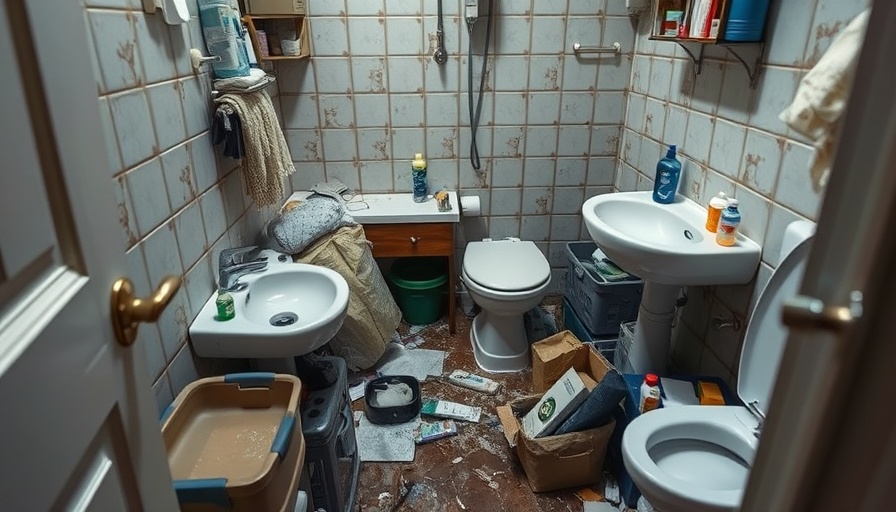
Understanding Common Bathroom Safety Mistakes
As essential rooms in our homes, bathrooms can also be a hub of unexpected accidents and injuries. Many adults aged 55 and older might overlook certain hazards that can lead to falls, burns, or poisoning. Each year, thousands of Americans experience accidents in their bathrooms, and with some precautions, these instances can often be prevented. This comprehensive guide will explore common bathroom safety mistakes, provide practical solutions, and empower homeowners—especially those with senior family members—to create a safer environment.
The Hidden Danger of Wet Floors: Slip Hazards
Statistics reveal that over 80% of bathroom accidents are caused by slips and falls. Wet floors, often a result of water splashed from sinks or bathtubs, present significant dangers. To combat this issue, it's essential to minimize slip hazards by installing non-slip mats or adhesive strips in areas most frequently exposed to water. Teaching family members to be diligent about hanging towels and keeping floors dry can also create a safer bathroom environment.
The Importance of Proper Lighting for Bathroom Safety
Good lighting is crucial yet often overlooked in the context of bathroom safety. For older individuals who may be less steady on their feet, dimly lit areas can lead to dangerous missteps. Bright, energy-efficient bulbs should illuminate all areas of the bathroom, including corners, to enhance visibility. Additionally, consider using motion-sensor lighting and night lights for nighttime trips—this simple addition can drastically reduce the risk of falls.
Preventing Hot Water Burns in Your Bathroom
Hot water burns are a serious concern, especially for children and the elderly. Scalding temperatures can inflict severe injuries in mere seconds. Homeowners should set their water heaters to a maximum of 120°F (49°C) to decrease burn risks. Installing temperature-regulating faucets and anti-scald devices offers an extra layer of protection. Teaching children about the hazards of hot water can also cultivate vigilant attitudes during bath time.
Organizing Care-Free: Storage Safety Tips
Storage safety is paramount in bathrooms, particularly regarding medications and cleaning supplies. Items should be kept out of reach of children and pets to prevent accidental ingestion or exposure. Storing hazardous materials in locked cabinets or on high shelves is vital. Furthermore, labeling containers and routinely reviewing expiration dates helps maintain organization, ensuring a clutter-free and safe space.
Temperature Regulation: Controlling Heating Risks
Beyond hot water, various heating risks exist in bathrooms, particularly from heating lamps or space heaters. Accidental burns can occur when these appliances are left unattended. It's crucial to ensure that any heating setup is adequately maintained and used according to safety guidelines. Installing thermostats on heaters can keep temperatures regular and prevent overheating.
Listening to Feedback: Elder-Friendly Designs
While making renovations, it's important to involve your senior family members in discussions about safety. Understanding their mobility challenges and preferences can aid in creating a more supportive bathroom environment. Features such as grab bars, walk-in tubs, and adjustable shower heads can enhance independence and security.
Emotional Insights: Navigating Bathroom Safety
For older adults, navigating daily routines in the bathroom may be fraught with anxiety about falling or sustaining injuries. Communicating openly about these fears can foster understanding and allow multiple family members to contribute to safety improvements. Establishing a fall recovery plan, such as keeping a cellphone nearby, can also alleviate fears for both the elderly and their caretakers.
Conclusion: Intentional Steps Towards a Safer Bathroom
Addressing bathroom safety is an ongoing commitment that involves being vigilant and proactive. By recognizing common pitfalls—from wet floors to poor lighting and hazardous storage—you can dramatically reduce the risk of accidents for yourself and your loved ones. Create a safer environment today, and empower those around you to share in this responsibility. Let's turn the bathroom into a sanctuary for self-care rather than a site for potential harm.
Ready to make your bathroom a safer haven? Start implementing these tips and ensure peace of mind for you and your family. Small changes can lead to significant safety improvements.
 Add Row
Add Row  Add
Add 




Write A Comment